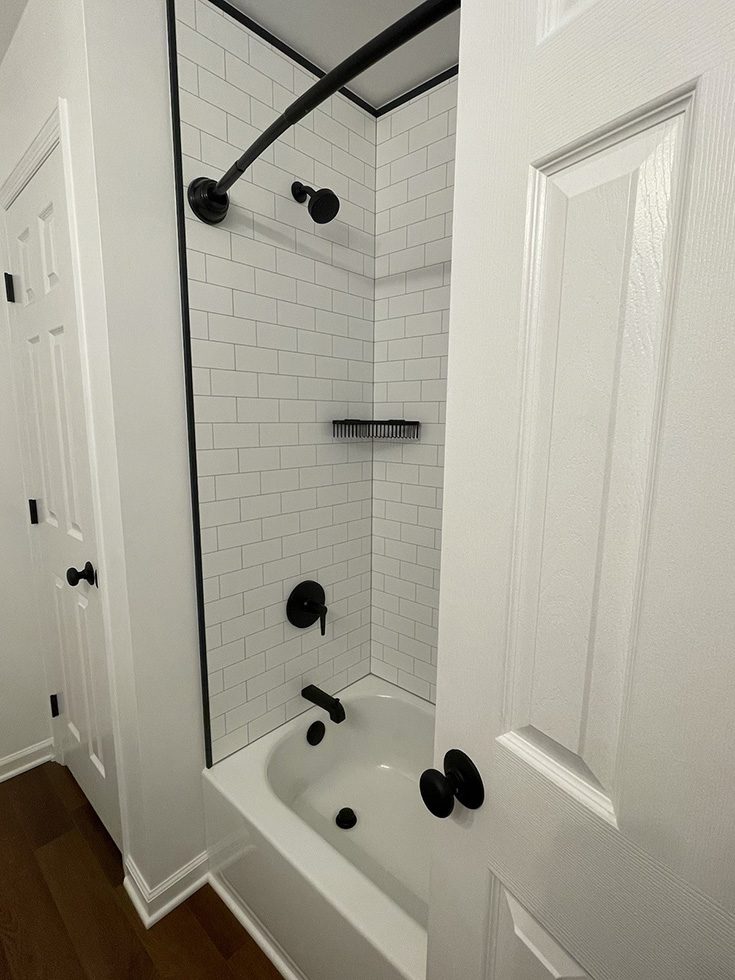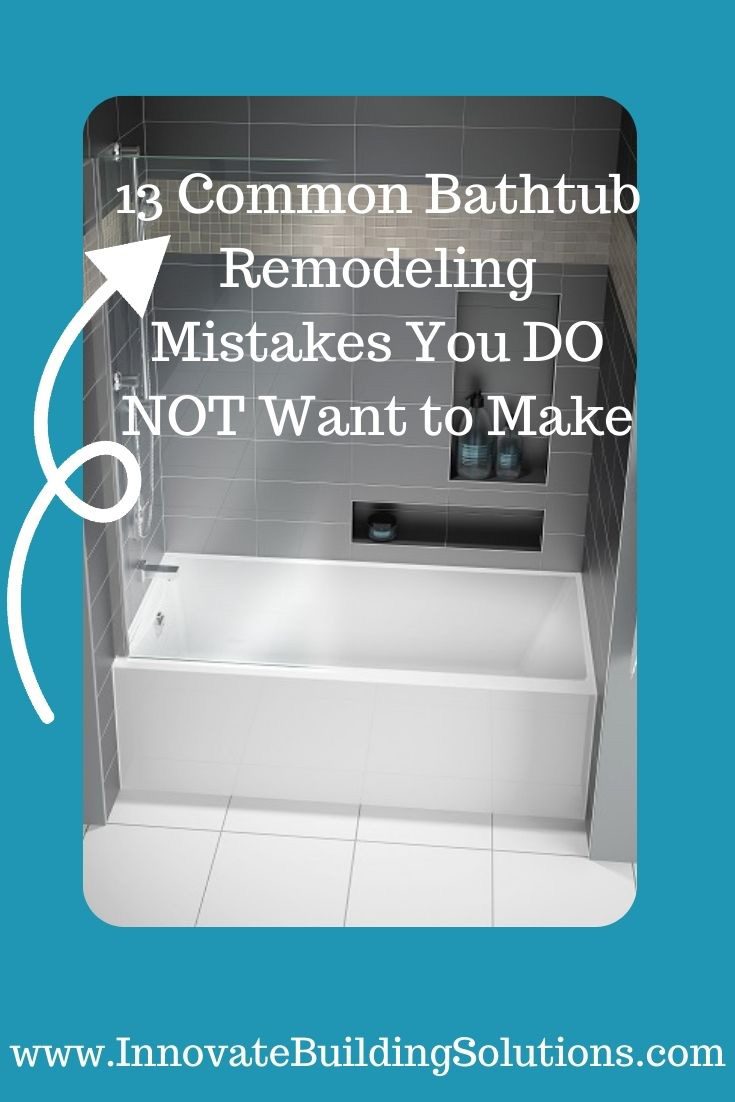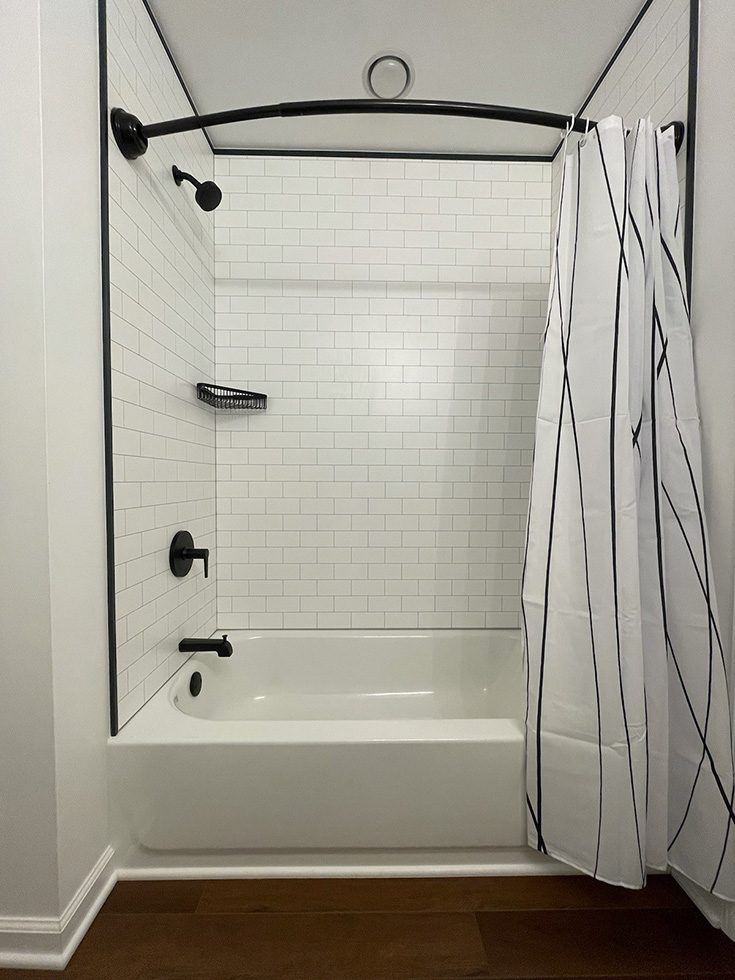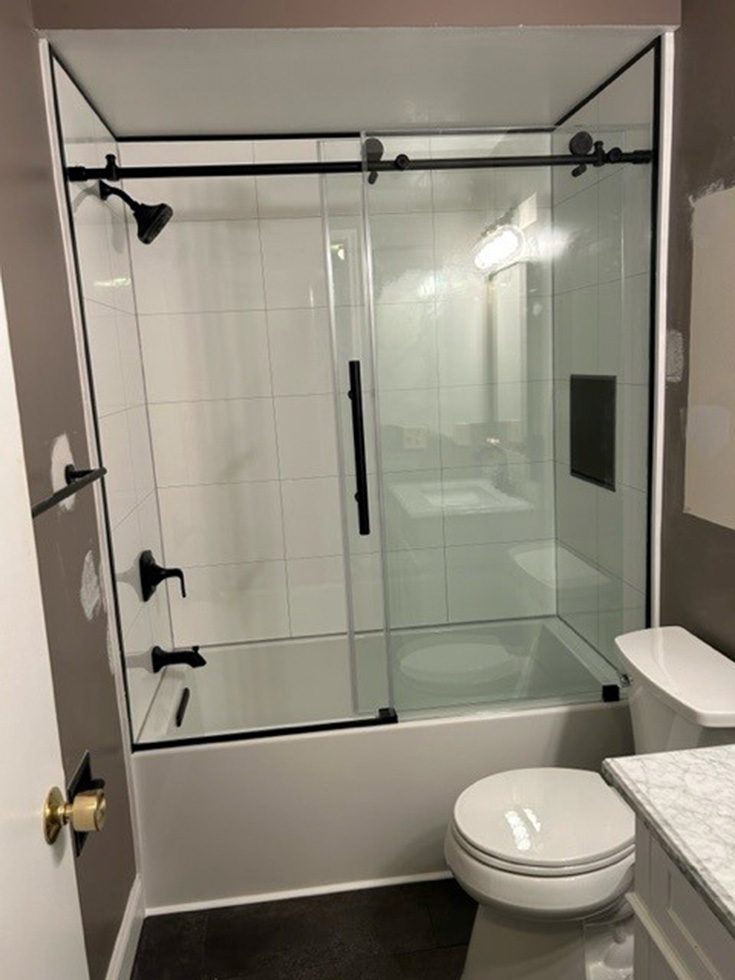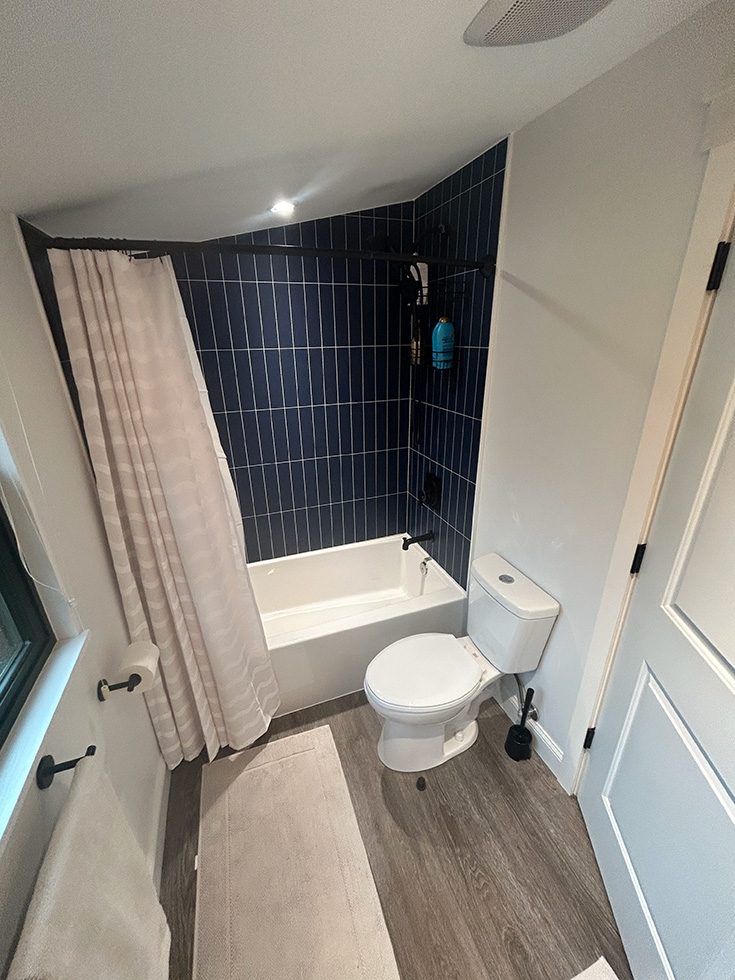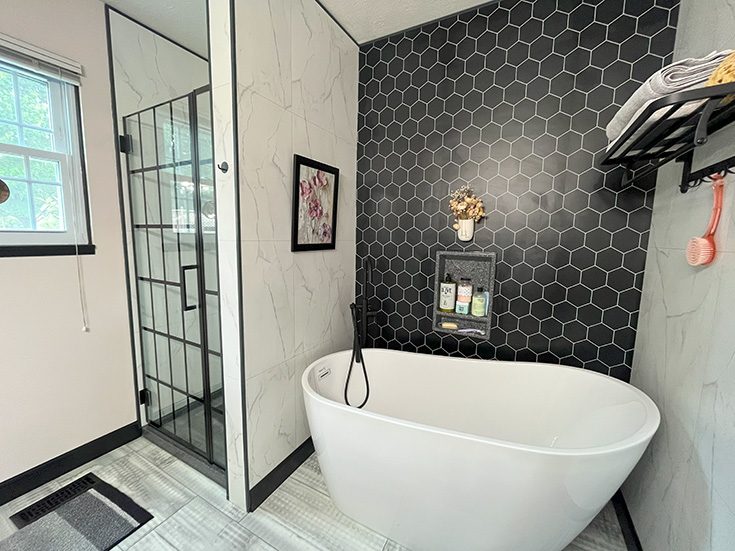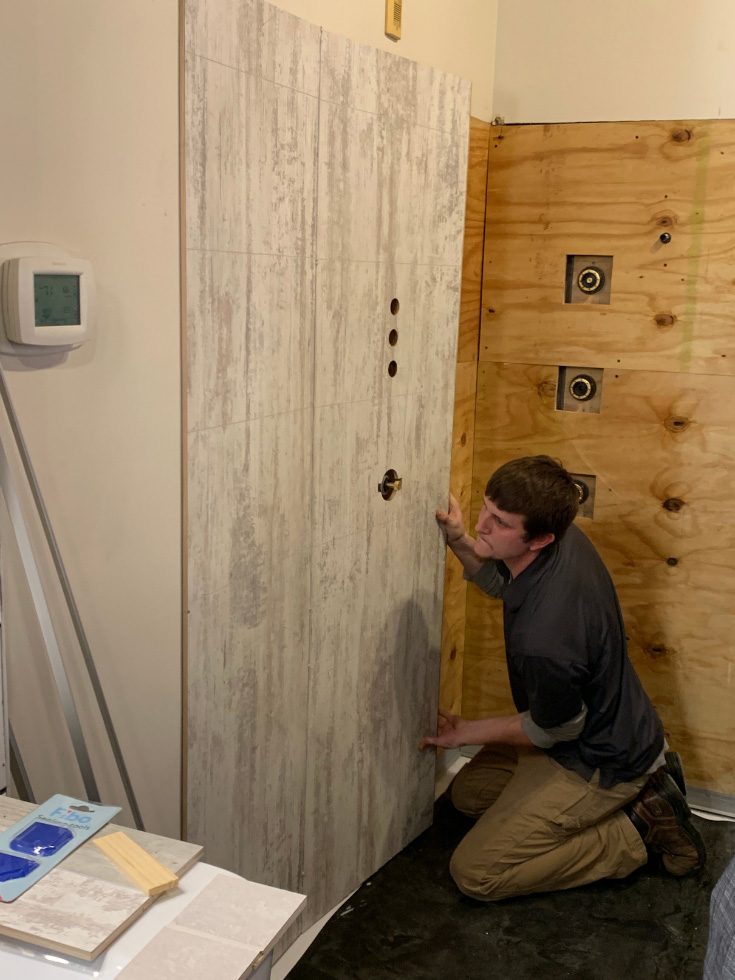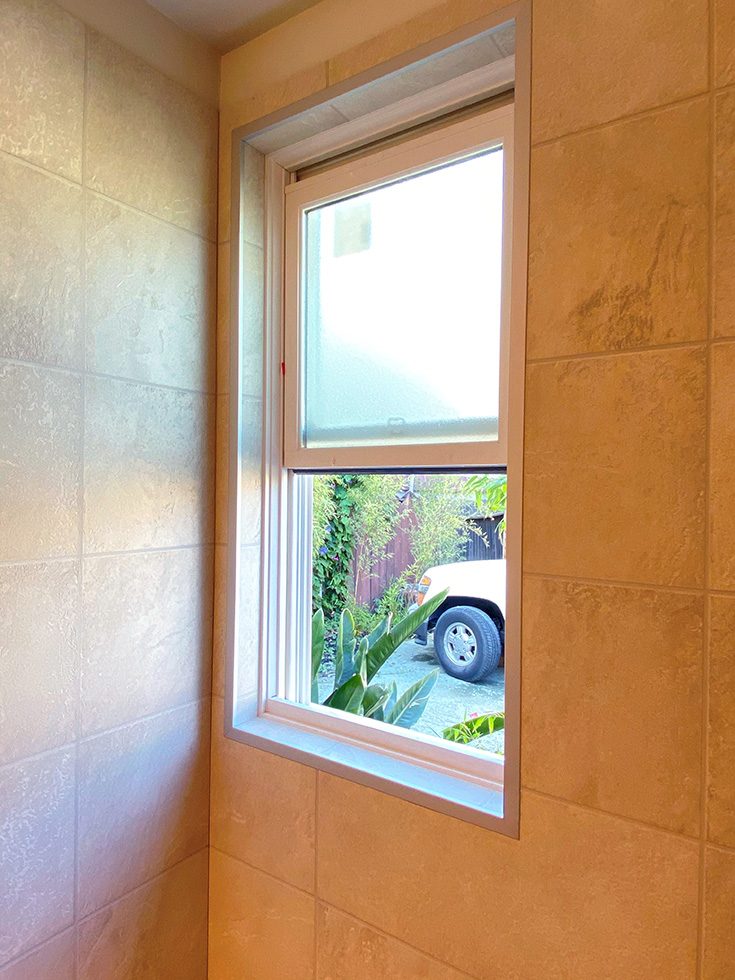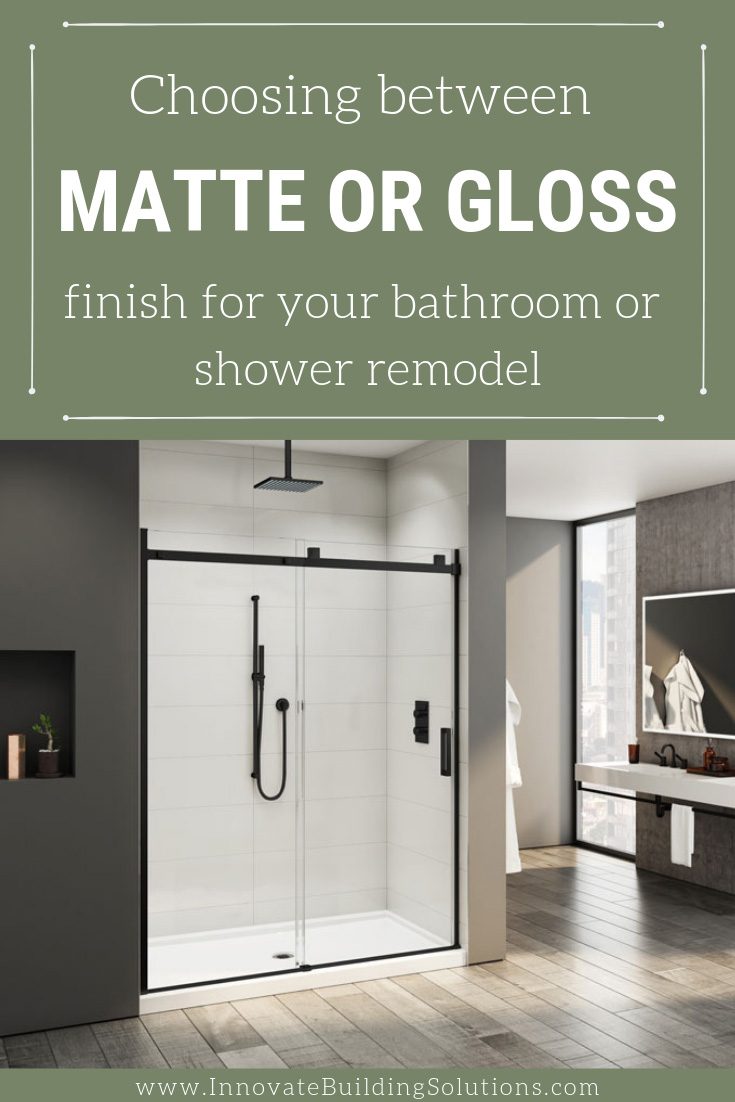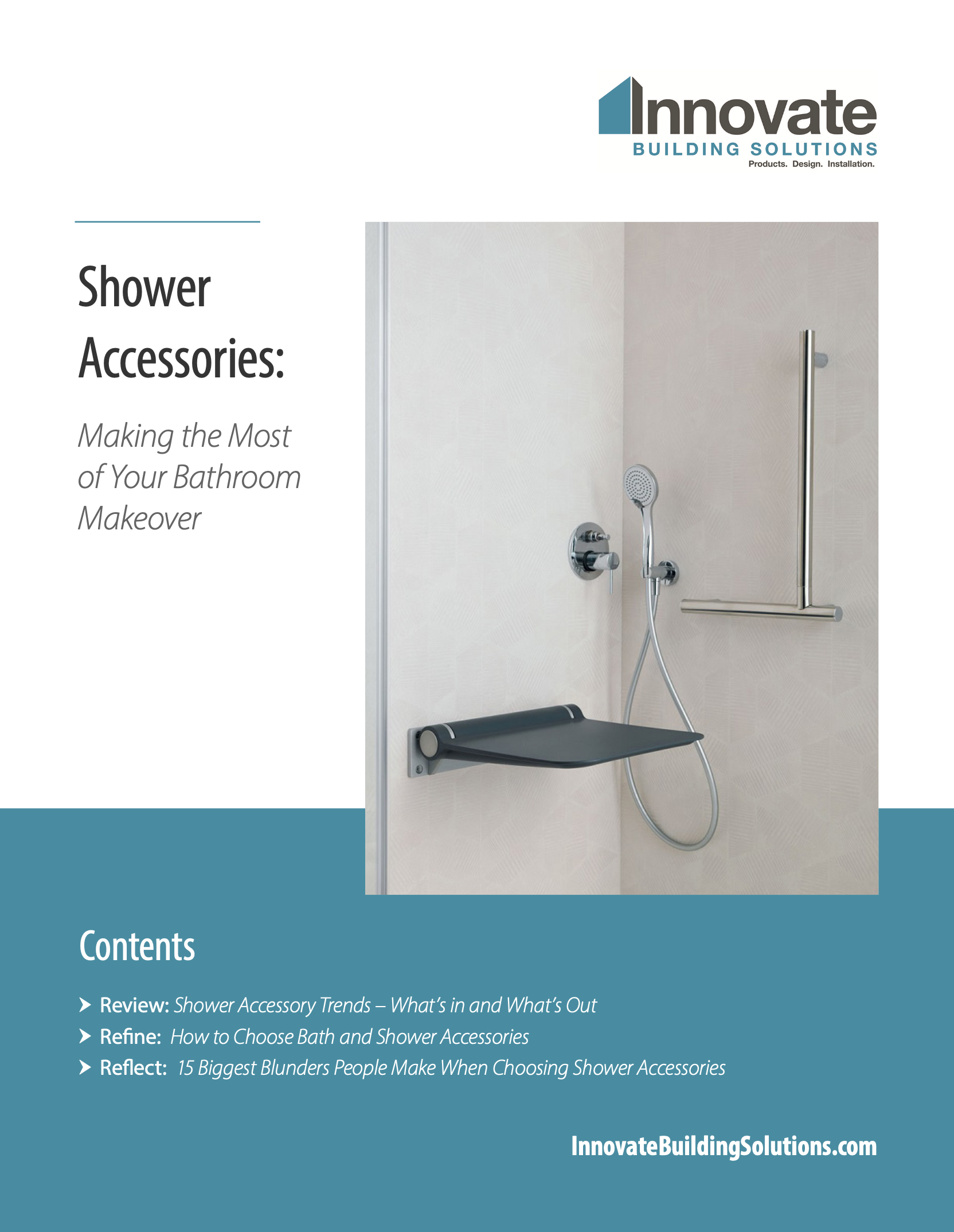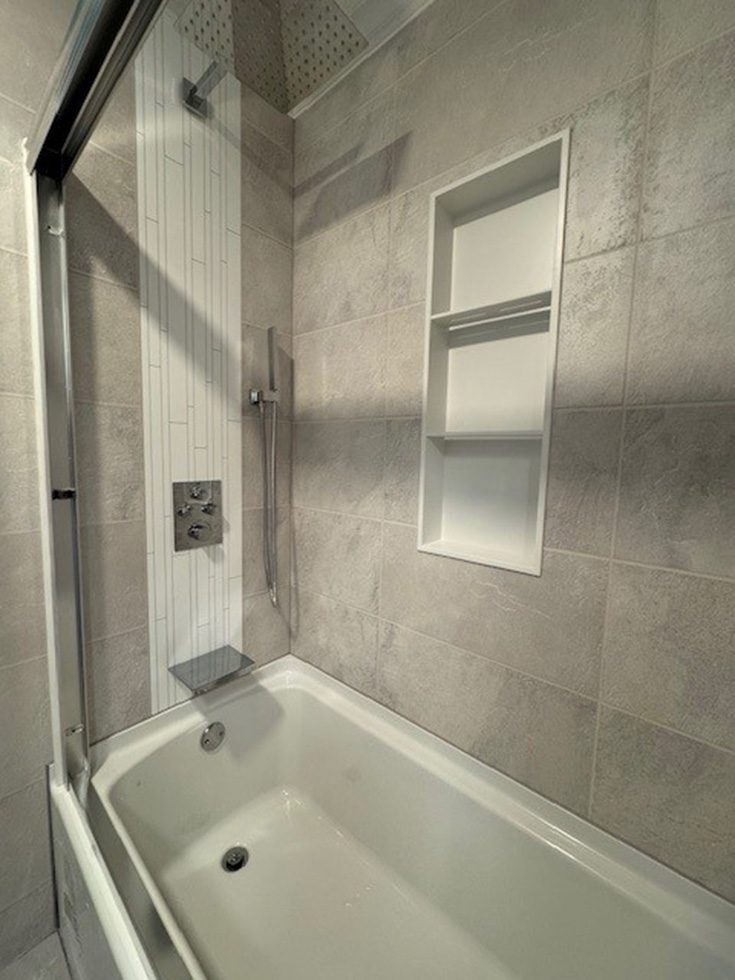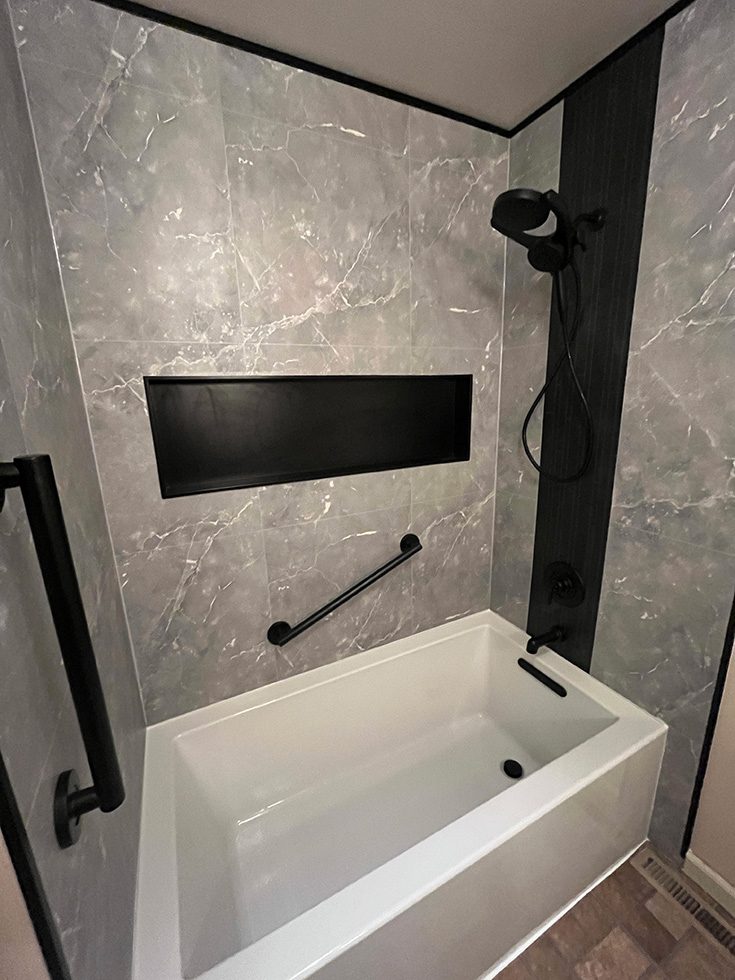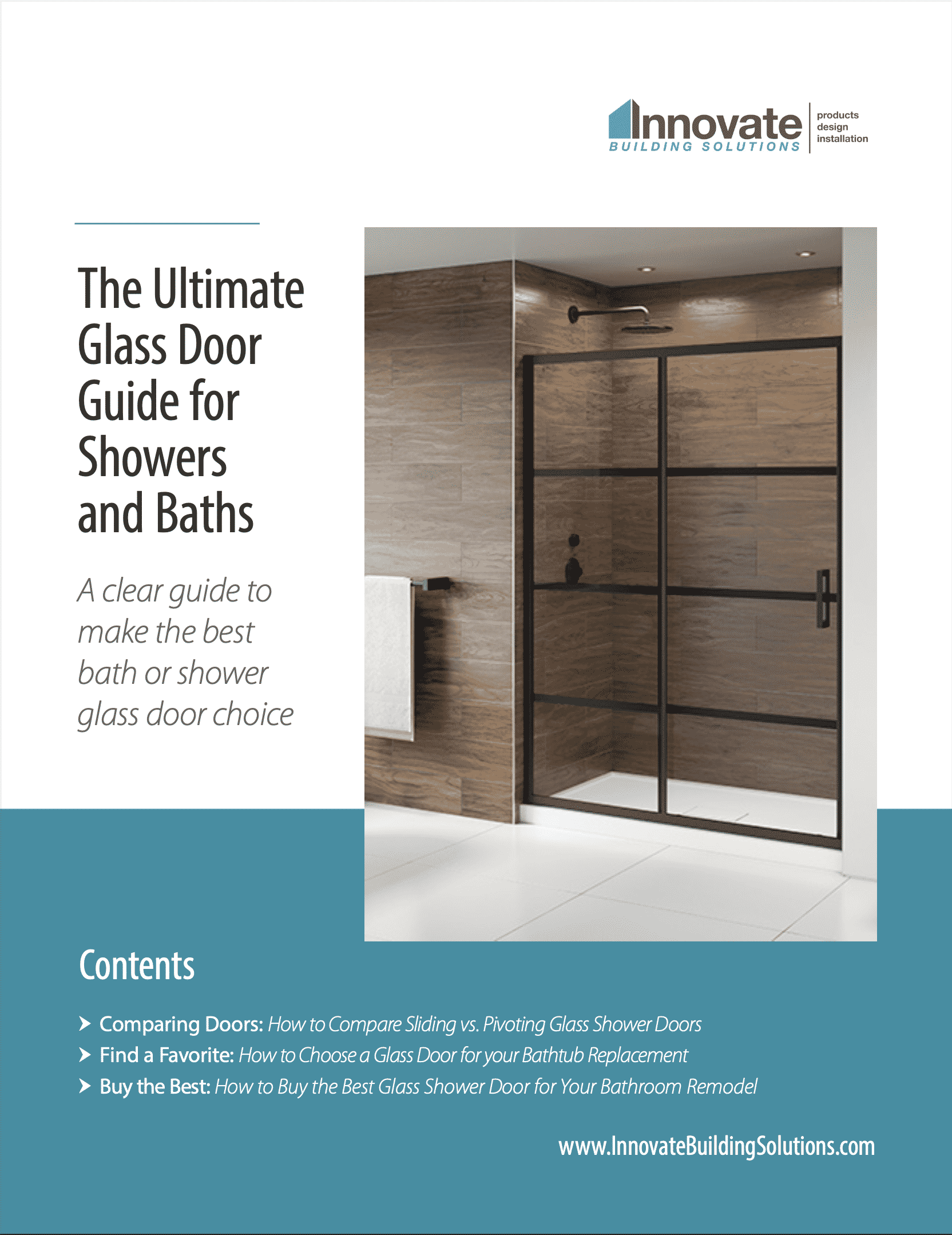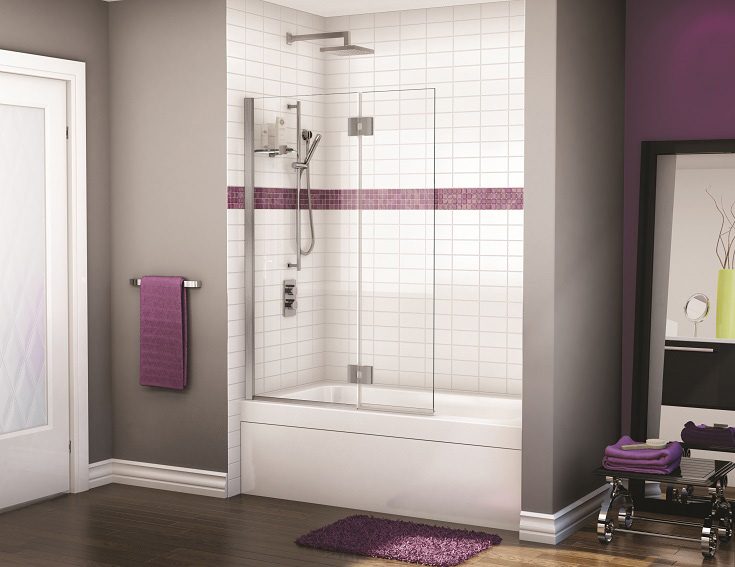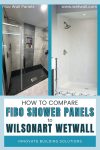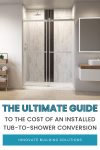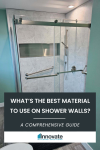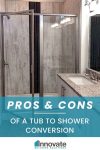How to Remodel Your Bathtub (and Tub Surround) and do it Right the SECOND TIME!
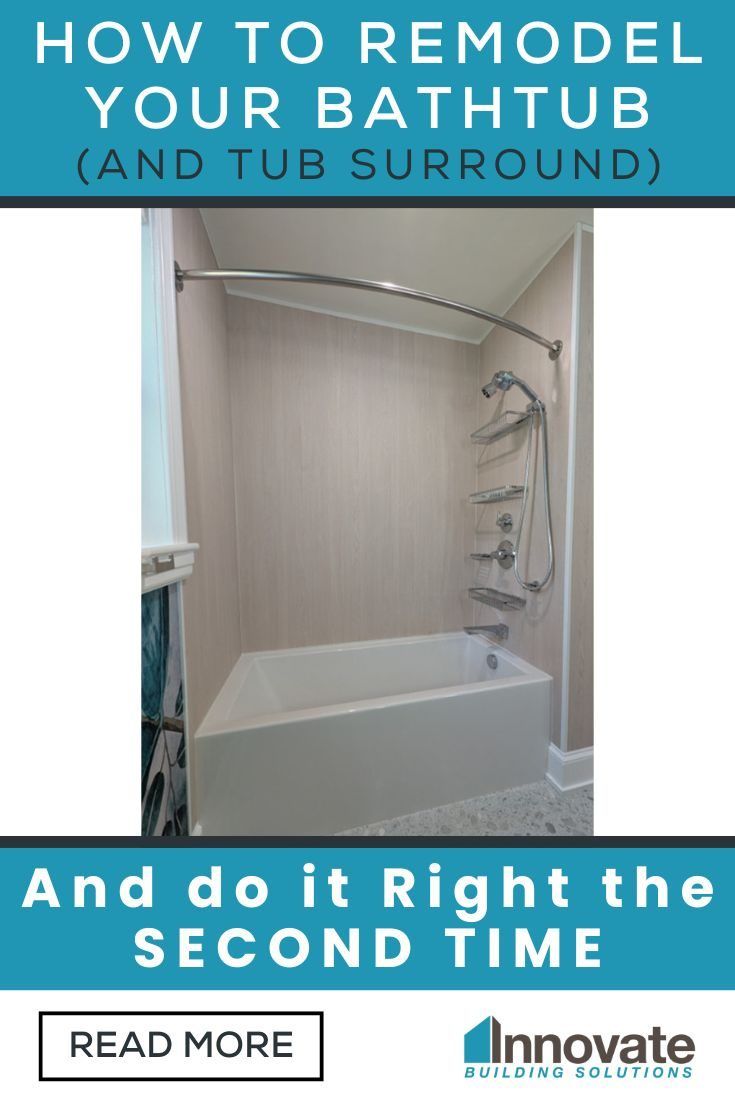
If you’ve got a butt-ugly tub and tub surround which begs the question, “What WAS the previous owner or builder thinking when they installed these god-awful materials?,” believe me you’re not alone.
In many ‘hall bathrooms’ (where tub and tub surrounds got together like peanut butter and jelly) it can feel like the original home builder – or previous owner – ran out of money when they chose these cheap, plasticky materials. Or maybe worse yet (if they have ceramic tiles surrounding the tub) they ‘ran out of gas’ after cleaning the tile joints in the master bath and left the hall bath to get moldier and moldier. YUCK!
And if you’ve ‘had it up to here’ (as my mom used to say when she got mad at my brother, sister, or I) with your nasty tub and tub surround walls and want to make sure you get it right the SECOND TIME (even if you weren’t responsible for the first time), you’ve come to the right article.
Below I’ll look at 5 steps to guide you to successful project if you’re removing an old, nasty tub (and tub surround), and want to replace it with better quality materials which are built to last, will look good for years to come, and NOT be a pain to maintain. And if you want to save a few bucks, read ‘Bonus Step 6’ to get more for your money. So, let’s dig in.
Step #1 – Understand your ‘why.’ Why are you replacing your existing tub and tub surround with another tub and tub surround?
All the rage in bathroom remodeling these days are ‘tub to SHOWER conversions.’ ‘Tub to tub conversions’ are definitely not as popular. And why you may ask? Here’s the biggest reasons most people are replacing a tub with a shower:
- You – or a family member wants to ‘age in place’ and a tub is harder to step over than a shower pan.
- More people shower, than bathe in a tub.
- It’s easier to get clean in a shower than bathing a tub.
- One level wet room showers can make a continuous room which makes a small bathroom feel larger.
- Its quicker to shower than bathe in a tub.
And although these are all good reasons to do the ever-popular tub to shower conversion, here’s reasons to replace your old tub and tub surround with a new tub and tub surround (a.k.a. a tub to tub conversion):
Reasons to do a tub to tub conversion
- You can get ‘double-duty’ using an alcove tub with surrounding wall panels. When you have an alcove tub (which is a tub inside 2 or 3 framed walls) you can also install a shower head so you can use it to take a bath or a shower.
- It’s good for resale or for a quality VRBO property– Without at least one tub in your home, there can be parents with small children (or grandparents with tiny grandchildren) who will find it harder to bath the little ones. This can hurt resale value for those who want a tub for ‘bathie time’ (and yes, that’s the technical term for it), or for someone looking to maximize potential vacationers from renting their VRBO property. This was a key reason Kevin Davis (the owner of Kevin Davis Construction) chose to upgrade ton an acrylic tub (from a fiberglass tub), yet to keep the tub function.
- It’s nice to relax in a tub- Whether you’re installing an alcove tub or a freestanding tub, walk in tub, or one with jets, it can be nice to have a place to relax in your bathtub after a tough day.
-
- It’s nice to ‘fix’ problems with the existing tub/tub surround – Perhaps you like a tub but wouldn’t dare bath in the chipped or cracked tub you own today. Or you find it impossible to clean your existing tub or tile tub surrounds. Or the area inside the tub is too small. When you do a tub to tub conversion you can use better materials – and buy a better designed tub (or tub surround) to eliminate these problems.
- You can choose the type of tub you’d like – Tubs are NOT created equal. When you’re doing a tub to tub conversion you can choose (A) an alcove tub – which butts up to framed walls or (B) a freestanding tub – which is very stylish and can be put anywhere in the room or (C) a walk in tub for therapeutic reasons.
So, now that you’ve thought about your ‘why’ to do a tub to tub conversion – let’s look at how to select the best bathtub for your project.
Step #2 – How to select the best bathtub
As in most remodeling projects the #1 fear people have is FOSU. And that’s the Fear Of Screwing Up. And if you’ve got that fear, read 13 Common Bathtub Remodeling Mistakes You DO NOT Want to Make.
However, with that being said, let’s look at the key features to consider in choosing the best tub for you to calm your case of FOSU down.
Feature #1 – What material is the tub made of?
Most existing alcove tube are made of fiberglass, which can be an absolute bear to maintain. When they get dirty they can be difficult to get clean. The biggest benefit of fiberglass tubs is they’re low cost. And that’s why so many original home builders use them.
And if you’re taking out an old tub it also might be made of cast iron. While cast iron won’t flex as you’re stepping on it because it’s heavy, it’s also prone to chipping, and expensive.
It’s for this reason today the most popular tubs used today in bathtub remodels are either acrylic, solid surface, or cast iron.
Acrylic tubs comes in a variety of sizes, drain configurations, and of different heights. And while they’re more expensive than fiberglass, they’re less costly than cast iron or solid surface tubs and are available from stock (and this can be critical if your project is on a tight time frame). It’s for this reason they’re high on the popularity list.
Another option are solid surface tubs. Some of these tubs weigh 500, 600, or 700 lbs. (like a heavy sumo wrestler) and that’s NOT including the weight of the water. Once they’re filled with 70 gallons of water – this adds another 584 lbs.! In addition, solid surface tubs are NOT a cheap date! However, solid surface tubs are durable, easy to clean, and high quality.
Feature #2 – What type of tub would be best? Do you want or need jets?
Tubs are NOT a one size fits all proposition.
If you want the best value option (and also get a ‘BOGO’ benefit– buy one function, get another function for free) the alcove tub is the way to go. Since it has flanges to waterproof it’s edges and built wall to wall in an alcove, it’s simple to use as a tub or a shower. And alcove tubs are generally the least expensive type of tub. So, if you’re still waiting for your Elon Musk inheritance money to show up (or for your Tesla stock to rebound)– this could be a good choice for you!
Another option are freestanding tubs. These stylish tubs are used mostly in ‘5 piece bathrooms.’ And if you don’t know what a 5 piece bathroom is, it’s one which has one shower, one tub, two sinks, and a toilet. They’re used mostly in master bathrooms. However, it’s also possible to use a freestanding tub in a small hall bathroom – although it’s harder to shower in them because the height of the sides of these tubs are taller than an alcove tub, and the freestanding tub doesn’t fit snuggly to the wall(s).
Another option is a drop in tub which is installed inside a platform. Sometimes drop in tubs have steps in front of them to step up before you enter the tub. Drop in tubs are usually used for larger soaking or jetted tubs.
Jetted and/or walk in tubs (which can also be a subset of the tubs mentioned above) are another option. These tubs offer therapeutic benefits and can be simpler to enter (in the case of walk in tubs). Their negatives are they’re expensive, they’re costlier to maintain, and with a walk in tub you have to get into it before filing it up with water (and wait for it to drain before you can get out).
Feature #3 – How tall is the tub?
The height of the tub is a feature more people should pay attention to. For example, if you’re mobility challenged, yet still want to have the tub function – you’ll want the tub height to be as low as possible (and 14” high is usually the shortest you’ll find). In addition, a low tub can be helpful if you’re short and will be bathing a small child because it’ll be easier on your back to do this than with a tall tub.
Alcove tubs are generally from 14” to 21” high. And one advantage (and disadvantage) of taller tubs is they’ll hold more water. This can be nice for a relaxing bath – but not as good for your water bill.
Freestanding tubs are generally taller than alcove tubs and can be up to 25” high with decorative backs which make relaxing even easier.
Feature #4 – How much room is inside the tub? What bathtub designs are best?
It’s interesting how few people pay attention to the design of the tub and how it’ll impact the comfort of using it.
Not only do you have the obvious question of how deep or wide you can make the tub (deeper is usually better -and sometimes when you’re doing a tub to tub conversion it can be nice to go from the old 30” deep to a 32” deep tub if the framed side walls are deep enough), but also what’s the ‘interior design’ of the tub itself. And NO, I’m not referring to the type of wallpaper you’re using at the bottom of the tub – ha! ha!
And if you’re not sure what I’m meaning by ‘interior design’ when it comes to a tub it’s the shape of the inside of the tub. If the tub has an extreme taper it can leave limited room to stand in the shower and/or for your butt to fit in the tub. The area inside the tub is called the ‘bathing well.’ Better tubs are designed with larger bathing wells with more room to stand for showering or sit for bathing).
Feature #5 – Will there be space around the edges of the tub for storage?
This can be a major drawback of a freestanding tub people don’t realize until AFTER the tub is installed. There’s no place (generally) on the tub for storage (although there are more manufacturers beginning to offer a storage shelf which attaches to the edge of a freestanding tub).
Many alcove tubs have ledges around 3 sides for storage, but the amount of space varies depending on the tub’s design.
One of the advantages of drop in tubs is they have a larger area around them for storage.
Feature #6 – Make sure you know your ‘left’ from your ‘right’ AND where the drain is located.
Ok, I don’t mean to be demeaning here, but since most tub drains are on the side you need to know what a ‘tub with a left hand drain’ is vs. a ‘tub with a right hand drain.’ Basically, when describing what you need you should be describing where the drain is when you’re ‘outside’ the tub – not inside the tub.
So, a left hand drain tub is one which has the drain is on the left hand side when you’re viewing it from outside the tub. Knowing this can help save on restocking fees and buying the wrong tub.
So, now that we’ve talked about tub features let’s turn our attention to tub wall surrounds.
Step #3 – How to select the best bathtub surround system
If you’re installing a common alcove tub, and if I’m being honest (and if I wasn’t being honest my mom would wash out my mouth with soap …..and does anyone even do that anymore???) it’s NOT usually the tub you (or others visiting your home) will notice when they enter your bathroom. No, it’s the walls surrounding your tub!
If those walls look dirty, dingy, moldy, or out of style they’re a HUGE turnoff. Who wants to be surrounded by nasty walls? ‘Err that’d be no one!
And while I’d love to tell you choosing walls surrounds is easy-peasy, I’d be lying if I did that. There’s more options than you can shake a stick at! So, how can you, or should you, go about choosing the best tub surround for your project? Here’s 9 questions to ask:
Question #1 – What tub wall surround product options are available?
When choosing a tub surround, you can first divide them in 2 categories.
Category #1 – Tub surrounds with grout (like tile, stone etc.)
Category #2 – Tub surrounds without grout. This can include (but isn’t limited to) fiberglass, FRP (fiberglass reinforced plastic), SMC (sheet molded compound), acrylic, cultured marble, cultured granite, high gloss acrylic, solid surface, laminate, PVC, granite and marble. And this is just a partial list, crazy I know!
And every one of these options has their strengths AND weaknesses (just like we do as people). However, after picking a few options from the list above consider the following questions to make your best choice:
Question #2 – What’s your budget for tub wall surrounds?
Oh – if only you had unlimited funds or you hit the Powerball numbers! Assuming this IS NOT your situation, budget matters.
Generally grouted tub wall surrounds professionally installed will be most expensive.
When it comes to ungrouted panels the least expensive are fiberglass, FRP, PVC, and SMC. These will also be the least ‘customizable’ (more about that later).
Mid-priced options will be cultured granite, laminate wall panels, and cultured marble.
At the top of the price scale (along with tile/stone) will be sheets of real granite or marble.
Question #3 – Does the tub surround look fake?
I don’t know about you, but I hate the look of cheap, plasticky, molded wall panels. They detract from a bathroom. It’s for this reason I shy away from FRP, fiberglass, acrylic, and molded cultured marble, and cultured granite.
What’s nice about tile and stone (if you can afford them) is they’re not fake – and offer unlimited design possibilities.
However, if you can’t afford tile or stone – yet want a realistic look, consider laminate wall panels. They’re life-like, aren’t hard to maintain, and reasonably priced.
Question #4 – How thick are tub surrounds?
While thinner tub surrounds won’t necessarily perform poorly – thicker panels are usually of better quality. Its for this reason I like tile, stone, cultured granite, and laminate tub panels. These materials are 3/8” thick, unlike the cheap, plasticky stuff you’ll see at home center stores.
Question #5 – Can a tub surrounds be customized to fit my space? Can you put a tub surround over an existing tub?
Did you go to your local home center and end up depressed when you figured out the ‘standard’ tub wall surround panels they stocked were NOT going to work around your odd-sized alcove, freestanding, or soaker tub?
The standard panels were either too short (and won’t reach the ceiling), not wide enough, or U-G-L-Y!
And while tile and stone are always an option for custom spaces – if you don’t like their cost, or installation or maintenance challenges with them, you’re not alone. It’s for this reason you’ll want to evaluate click-lock style wall panels. They give you the ability to cover any alcove or bathroom space no matter how big or small you need because they’re modular panels which are locked together (for unlimited sizes) and can be cut to fit any wall dimension.
And if you’re wondering, its nice to know you can install a tub surround (of any size) over your existing tub. So, if you do want to upgrade your tub surround walls – yet keep your existing tub, it’s possible.
Question #6 – Can your tub surround system work around windows, or other crazy obstructions?
Let’s face facts, sometimes a home with ‘character’ can be a pain in the rear. For example, a window in the middle of the tub wall in an old home. is nice to make the room feel open (and is better for aging in place), but some wall surround panels offer no solutions on how to work around a window.
Or a room with a sloped ceiling is cool, but finding wall surround panels to fit your ceiling height variation can be a pain.
In other cases, a soffit above a tub surround requires a special size and the need to cut materials.
It’s for this reason you need a wall surround system which is simpler to cut around the weirdness which is your home.
Some systems which are good for odd sizes and crazy obstructions include PVC wall panels (which have window trim kits), tile (which can be cut to fit), cultured granite panels (with stone window kits), and laminate wall panels.
Question #7 – Will the wall surrounds be easy for me, or my contractor, to install?
It’s important to keep in the mind the total cost of tub surrounds is NOT just the price of the materials – but it’s the price of the materials PLUS labor.
And what you’ll see with tile is there’s a lot of labor prepping for tile (with backer board, thin set, waterpoofing etc.) cutting tile, grouting tile, and owning (or renting) tools to install a nice-looking finished job. And as a matter of fact as Kevin Davis (of Kevin Davis Construction) told me, “Mike, I decided to use simple to install laminate wall panels not only because they’re a quicker system to install, but also because in my VRBO property I need them to be durable.”
It’s for this reason it’s good to get installed pricing and not only focus on material prices.
If you’re looking to DIY your tub surrounds watch installation videos AND read reviews. Does your potential supplier offer installation assistance or will your C.S.R. (Customer Service Rep) be nowhere to be found when you have installation questions? Big box stores and e-commerce sites are notoriously baaaaaad in this area.
See if you can find qualified installers who are familiar with the material you’d like if doing it yourself ‘ain’t your bag,’ or if you’re doing it yourself make sure installation support is available.
Question #8 – Can you choose from gloss AND matte finishes in your selected tub surround material?
There are tub surrounds which only come in gloss finishes.
Then there are tub surrounds which only come in matte finishes.
And finally, there’s tub surrounds you can get in matte and gloss finishes.
And before you choose which is best for you, it’s smart to know when to choose matte, and when to choose gloss. And if you’re not sure read 7 Critical Things You Need to Know Between Choosing Matte or Gloss for your Bathroom.
Question #9 – What’s the warranty of your tub surround?
I have to tell you I’m blown away by how few people never ask what the warranty is with expensive tiles they’re having installed until AFTER they fail!
The reality is grout joints can (and do) fail. And, in addition, the waterproofing of a tile job is behind the wall (which is what you don’t see after the tile is installed), and few people even know (or understand) what the contractor is using. So, make sure you know what backer materials and grout your contractor is using to prevent leaks.
In addition, generally the cheaper the wall panel, the shorter the warranty.
Before choosing a tub surround system ask about its material AND installation warranties.
And now let’s look at those all-important (yet often forgotten) tub accessories.
Step #4 – How to choose accessories for your tub and tub surround
While the right tub and tub surrounds are critical, your successful tub to tub conversion project planning isn’t done quite yet. No, accessories can make or break how well a new tub (and tub surround) works for you.
Tub and tub surround accessory #1 – Shelves, niches, and storage
Seemingly the older we get the more ‘stuff’ (lotions, potions etc.) we need to get ‘gussied up’ (or at least look presentable). And this requires more storage options for this ‘stuff’ in and around the tub/shower.
For example, if your alcove tub/shower is mostly used for showering then corner shelves can be smart. If you’ll be bathing in the tub frequently, then make sure there’s either enough space around the tub’s edge for products or install a vertical niche so products are close to the top of the tub.
And if you’re using a freestanding tub you’ll either need something to hang on the edge of the tub, or furniture outside the tub for your shampoo and soap, or you’ll need to buy a newly designed freestanding tub with an integral storage shelf.
Tub and tub surround accessory #2 – A tub surround window trim kit
If you’re working around a window, and are using grout free panels, you’ll need a system which can work around the window (and keep everything waterproof). This is called a window trim kit. Don’t leave your tub surround without them.
Tub and tub surround accessory #3 – A place for towels or robes
Perhaps you’ll want hooks or a towel bar which can double as a grab bar, so you don’t have to go ‘full-Hillbilly’ and drape towels over the curtain rod or tub door (more about doors and curtains later).
Tub and tub surround accessory #4 – Grab bars
The number one place falls occur is getting into, or out of, a tub. That’s why a vertically oriented grab bar at the entrance is the way to go. And if you’re really being smart use a 36” or 42” size vertical grab bar at the entrance so if you do fall, you’re still able to reach the bar to pull yourself up.
Or another idea is to install a grab bar at an angle on the long back wall to make it easier to prop yourself up when getting out of the bathtub.
And now let’s turn our attention to the #1 feature to keep water INSIDE the tub (and not on the bathroom floor) and consider whether you should choose curtains or a glass tub door.
Step #5 – A tub door, or curtains… that is the question
There can be compelling reasons to use a glass tub door, a glass shower screen, or curtains depending on your budget, how you’re going to use your tub (or tub/shower combo), or how long you’re going to stay in the home.
For example – tub doors are best when…..
- You’re going to mainly use the tub/shower space for showering
- You want to keep water in
- You want a system which is easier to clean.
- You want to see your tub surround walls.
- You want a modern look.
- You want more light inside while showering.
And curtains are better when….
- You’ve got a tighter budget.
- You’re renting and can’t take the doors with you.
- You’re going to be bathing a little one frequently.
- You want more privacy.
And lastly there’s a hybrid option which is called a tub screen which has a fixed glass door on one end – with a small pivoting door at the side. With a walk in tub door system it’s not only cheaper than a full bypass tub door (which has two sliding glass doors which go wall to wall) – but it is easier to bath a child (near the open end of the tub) and have a pivoting door which can be angled to keep water in when showering.
And Bonus Step #6 – How to save a few bucks on a tub, tub surround, and tub enclosure project
Since most of us wouldn’t describe ourselves with the M.O.M. acronym (which… surprise, surprise… stands for Made Of Money), it’s critical to make smart purchases. That’s where saving money – without sacrificing quality, comes in. And here’s 3 ideas to accomplish this goal.
Idea #1 – Buy it yourself
Even if you’re not going to install it yourself, some smaller contractors will let you buy materials which’ll save you on material markups. However, note most mid to large contractors will NOT let you do this because they want to control the quality of materials used AND make money selling these materials to you.
Idea #2 – Buy a complete tub kit (which includes the tub, tub surround panels and/or a tub door)
When you buy a complete tub kit they’re priced more cost-effectively because multiple products are being shipped at the same time. And, in addition, the supplier will be matching the products, so everything works together (and you won’t have costly returns and restocking fees).
Idea #3 – Don’t be ‘penny-wise and pound foolish’
This is an idea my dad cemented in my head years ago. He’d tell me, “Michael, don’t be penny wise and pound foolish.” Or specifically with this project, don’t buy an uber-cheap tub which cracks under the weight of your family using it. Or don’t buy cheap wall surrounds you can’t clean. Or don’t buy a flimsy glass shower door with tracks which are a P.I.A. to clean.
Buy good value products which stand the test of time.
So, do you feel you have the right ‘formula’ to remodel your tub with a better tub and tub surround the ‘second time around?’ Do you need help with this project?
Why is nothing quite as simple as it seems at first? Because before you read this article you might have thought just get a tub and some walls and be done with it.
There ARE complexities when it comes to tubs, tub surrounds, and the accessories, glass doors, or curtains which come with them.
Selections can be daunting, but it’s good to know there’s help if you need it.
If you have product questions call 877-668-5888 or click for a Free Design Consultation to get assistance from a Bathroom Product Specialist at Innovate Building Solutions (OK – I’ll admit that’s my company).
Or if you’re looking for someone to install a tub to tub conversion (or tub to shower conversion) in Northeast Ohio (Cleveland, Akron etc.) call 216-531-6085 or ask us for a referral to a contractor across the country who is in our bathroom dealership program if you’re not in Ohio.
Thanks for reading (and putting up with my – at times – wacky humor!).
Mike
###
If you want more advice follow me on LinkedIn @MikeFoti.
And if you’re a bathroom remodeling contractor interested in being a dealer of shower wall panels, shower pans, glass shower door systems and freestanding or alcove tubs, call 888-467-7488 and ask for Mike.
